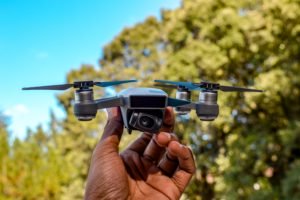The FAA’s proposal for Remote ID for drones appears problematic for the recreational drone community. Tyler Dobbs, the AMA‘s Director of Government Affairs, says the proposal leaves “no viable options” for hobby flyers. Dobbs says that without changes, the current proposal will not only force law abiding flyers out of the hobby, but cause a massive problem with general compliance.
Dobbs explains the AMA’s interpretation of the rule simply. “There are three options to comply with the Remote ID rule,” says Dobbs. “First is the standard option: connect with the internet and provide location and identification to one of the USS service providers, or, if you lose internet connection, broadcast… we see this as really designed to support flight beyond visual line of sight.” Retrofitting all recreational aircraft to the standard would be almost impossible, says Dobbs. “Our members have aircraft that are 50 years old – we just don’t fit into the description of the aircraft that the FAA is working with.” For those future engineers building their own aircraft, Dobbs says the requirement is even more difficult to comply with: “It would be extremely difficult for home built or amateur built aircraft to meet the requirements,” he says.
“Second is the limited option, that requires you to be connected to the internet – but you are limited to 400 feet away from the controller,” says Dobbs. “That 400 feet is a deal killer for us. We have hobbyists flying soaring aircraft, large model aircraft, turbine jets. It just doesn’t work.” Not only is the 400 foot limitation a problem, says Dobbs, but so is the requirement for a connection: “Our flying sites around the country are deliberately chosen in rural areas away from air traffic – but those locations have poor internet connectivity.”
“Neither the standard or the limited are viable options for our community as a whole,” says Dobbs.
“Third is flying from a fixed site that’s been exempted by the FAA. That’s the one most people think that we should be able to work with,” Dobbs explains. “But in addition to requiring the CBO [community-based organization] to go through that process for every site with the FAA, there is currently only a 12 month window to request sites – and after 12 months the window closes.” The current regulation calls for permission to fly at a fixed site to be requested within a 1 year period, after which no new sites could be added to the list. As AMA flying sites frequently change locations, or some close and others open, that means that within a few years the AMA’s available sites would be severely limited. “We need the 12 month period for requesting flying site to be permanent,” says Dobbs.
It isn’t only the remote ID requirements which pose a challenge, but also the requirement for one registration per aircraft rather than per operator. “We have members who have hundreds of aircraft,” says Dobbs. “Both in time and in cost, they just can’t register each aircraft. We’re just not going to get the compliance that they’re looking for. ”
While the AMA has worked hard to communicate with the FAA and its members over regulations, the rules have gotten increasingly difficult to follow – and while AMA members are those trying to meet requirements, the general public may simply choose to ignore regulations that they don’t understand. “It’s hurdle after hurdle after hurdle – the compliance simply won’t be there,” says Dobbs. “This is being targeted towards groups that are trying to follow the rules…. But I just don’t see a plan in place for getting this information to the public.”
The good news for recreational flyers is that they’re not alone on this issue. “Thankfully, we’ve gotten a lot of support from the industry,” says Dobbs. “I’m not sure that I’ve spoken with anyone who is happy with this as written.”
Miriam McNabb is the Editor-in-Chief of DRONELIFE and CEO of JobForDrones, a professional drone services marketplace, and a fascinated observer of the emerging drone industry and the regulatory environment for drones. Miriam has a degree from the University of Chicago and over 20 years of experience in high tech sales and marketing for new technologies.
For drone industry consulting or writing, Email Miriam or (for paid consulting engagements only) request a meeting through AdvisoryCloud:
TWITTER:@spaldingbarker
Subscribe to DroneLife here.
https://dronelife.com/2020/01/17/dronelife-exclusive-amas-tyler-dobbs-on-rid-and-recreational-drones-no-viable-options/
 Unmanned Aerial Vehicle The latest drone news
Unmanned Aerial Vehicle The latest drone news





